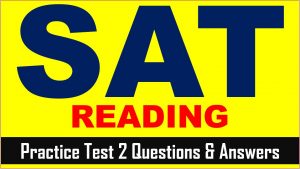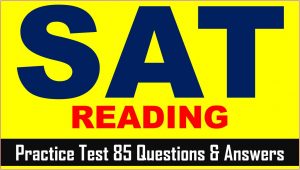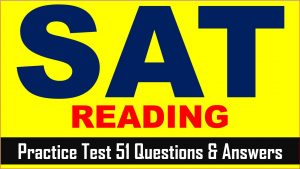SAT (Scholastic Assessment Test) is a standard test, used for taking admission to undergraduate programs of universities or colleges of the United States. SAT is developed and published by the College Board, an organization in the United States, administered by the Educational Testing Service. In this article of AKVTutorials, you will get Kaplan SAT Tutoring Course Book Review | Practice Test 14 AMBiPi.
Kaplan SAT Tutoring Course Book Review
Let’s start to know full details of Kaplan SAT Guidance Book.
Kaplan is a publishing company, in New York, that clearly declared that SAT is a registered and owned by College Board and this Kaplan SAT Book is not endorsed by College Board.
In this book, the authors and reviewers share their guidance of clearing SAT exam 2023.
According to these authors of Kaplan SAT preparation book, any aspirant can get a great SAT score from active engagement of this book. Kaplan provides a direction, focus your SAT preparation and teaches you specific skills that is required to crack SAT exam 2023.
In this Kaplan book for SAT, practice tests are just like actual SAT exam. By practicing these tests, you will prepare yourself for the actual test day experience.
Every chapter in Kaplan start with “How Much Do You Know”, where a typical question is asked related to SAT exam syllabus and at the end of the chapters a practice set is given and hence you check “How Much Have You Learned”.
In Kaplan SAT Prep Plus Book, there are following parts
- Part 1: The SAT and You
- Part 2: SAT Math
- Part 2A: The Heart of Algebra
- Part 2B: Data Analysis
- Part 2C: Passport to Advance Math
- Part 2D: Other Topics in Math
- Part 3: SAT Reading
- Part 4: SAT Writing and Language
- Part 6: Countdown to Test Day
- Part 7: Practice Tests
Kaplan is enormous publishing company that releases various books and course for the SAT preparation and hence it following books for SAT preparations
Kaplan SAT Prep Plus Book Pros and Cons
Pros
- Kaplan SAT Prep Book contains all the three sections of SAT exam, which provides acceptable broad details of the SAT test.
- Five full length SAT Practice test. Two in the book and Three in Online.
- More than 2000 practice questions with detailed explanation.
- Pre-quizzes in each chapter which identify what you already know
- Mixed practice quizzes after every chapter to assess how much you have learned.
Cons
- The actual FREE College Board tests available on its official site, is not given in the SAT Prep Book.
SAT Reading Practice Passage
Passage 1 is adapted from Talleyrand et al., Report on Public Instruction. Originally published in 1791. Passage 2 is adapted from Mary Wollstonecraft, A Vindication of the Rights of Woman. Originally published in 1792. Talleyrand was a French diplomat; the Report was a plan for national education. Wollstonecraft, a British novelist, and political writer wrote Vindication in response to Talleyrand.
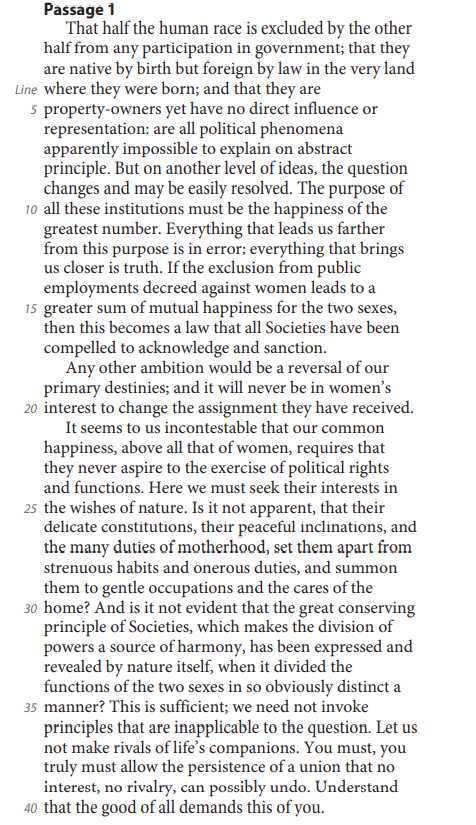
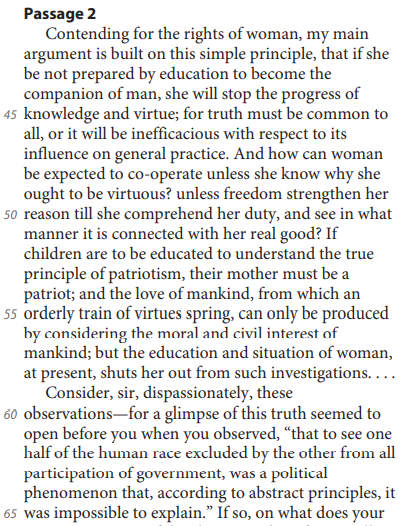
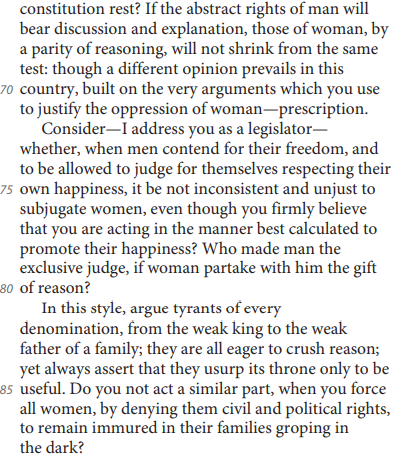
SAT Reading Comprehension Practice Test Questions
SAT Practice Test 14 Question No 1
As used in line 21, “common” most nearly means
Option A: average.
Option B: shared.
Option C: coarse.
Option D: similar.
SAT Practice Test 14 Answer No 1
Show/Hide Answer
Option B :
In lines 21-24, the authors of Passage 1 state society’s “common happiness” is dependent on women never becoming involved in politics. In this context, the authors of Passage 1 are suggesting that all members of society can have a “common,” or shared happiness.
Choices A, C, and D are incorrect because in this context, “common” does not mean average, coarse, or similar.
SAT Practice Test 14 Question No 2
It can be inferred that the authors of Passage 1 believe that running a household and raising children
Option A: is rewarding for men as well as for women.
Option B: yield less value for society than do the roles performed by men.
Option C: entail very few activities that are difficult or unpleasant.
Option D: require skills similar to those needed to run a country or a business.
SAT Practice Test 14 Answer No 2
Show/Hide Answer
Option C :
In lines 25-30, the authors of Passage 1 state that women should seek “gentle occupations and the cares of the home” so they can avoid performing difficult, or “strenuous,” and unpleasant, or “onerous,” tasks.
Choices A, B, and D are incorrect because the authors of Passage 1 do not suggest that running a household and raising children are rewarding for both sexes, yield less value for society or require professional or political skills.
SAT Practice Test 14 Question No 3
Which choice provides the best evidence for the answer to the previous question?
Option A: Lines 4-6 (“they are… representation”)
Option B: Lines 13-17 (“If the… sanction”)
Option C: Lines 25-30 (“Is it… home”)
Option D: Lines 30-35 (“And… manner”)
SAT Practice Test 14 Answer No 3
Show/Hide Answer
Option C :
In lines 25-30, the authors of Passage 1 provide evidence that women should run households and raise children because these roles do not require “strenuous habits and onerous duties.”
Choices A, B, and D do not provide the best evidence that running a household and raising children entails very few activities that are difficult or unpleasant; rather, these lines offer general information about the differences between the sexes.
SAT Practice Test 14 Question No 4
According to the author of Passage 2, for society to progress, women must
Option A: enjoy personal happiness and financial security.
Option B: follow all currently prescribed social rules.
Option C: replace men as figures of power and authority.
Option D: receive an education comparable to that of men.
SAT Practice Test 14 Answer No 4
Show/Hide Answer
Option D :
In lines 41-46, Wollstonecraft argues that if women do not receive an education “to become the companion of man,” or one that is comparable to men’s education, then society will not progress in “knowledge and virtue.”
Choices A, B, and C are incorrect because Wollstonecraft does not suggest that society can progress only if women have happiness and financial security, follow societal rules or replace men as figures of power.
SAT Practice Test 14 Question No 5
As used in line 50, “reason” most nearly means
Option A: motive.
Option B: sanity.
Option C: intellect.
Option D: explanation.
SAT Practice Test 14 Answer No 5
Show/Hide Answer
Option C :
Wollstonecraft argues that women should be granted an education comparable to men’s so that truth is “common to all” (lines 41-46). Wollstonecraft states that education will “strengthen [women’s] reason till she comprehends her duty” (lines 49-50). In this context, Wollstonecraft is arguing that education will improve women’s “reason,” or intellect, and allow women to consider their role in society.
Choices A, B, and D are incorrect because in this context “reason” does not mean motive, sanity, or explanation.
SAT Practice Test 14 Question No 6
In Passage 2, the author claims that freedoms granted by society’s leaders have
Option A: privileged one gender over the other.
Option B: resulted in a general reduction in individual virtue.
Option C: caused arguments about the nature of happiness.
Option D: ensured equality for all people.
SAT Practice Test 14 Answer No 6
Show/Hide Answer
Option A :
In lines 72-78, Wollstonecraft argues that the laws passed by society’s leaders allow men to “contend for their freedom” but serve to “subjugate women.” In this context, “subjugate” means to control. Wollstonecraft is arguing that society’s leaders grant men freedoms that are denied to women.
Choices B, C, and D are incorrect because Wollstonecraft does not claim that society’s leaders have granted freedoms that created a general reduction in individual virtue, caused arguments about happiness, or ensured equality for all people.
SAT Practice Test 14 Question No 7
Which choice provides the best evidence for the answer to the previous question?
Option A: Lines 41-45 (“Contending… virtue”)
Option B: Lines 45-47 (“truth… practice”)
Option C: Lines 65-66 (“If so… rest”)
Option D: Lines 72-75 (“Consider… happiness”)
SAT Practice Test 14 Answer No 7
Show/Hide Answer
Option D :
In lines 72-75, Wollstonecraft provides evidence that society’s leaders grant freedoms that privilege men. She argues that while society’s leaders believe they “are acting in the manner best calculated to promote [women’s] happiness,” their decisions don’t allow women to “contend for their freedom.”
Choices A, B, and C do not provide the best evidence that society’s leaders grant freedoms that privilege men over women.
SAT Practice Test 14 Question No 8
In lines, 61-65, the author of Passage 2 refers to a statement made in Passage 1 to
Option A: call into question the qualifications of the authors of Passage 1 regarding gender issues.
Option B: dispute the assertion made about women in the first sentence of Passage 1.
Option C: develop her argument by highlighting what she sees as flawed reasoning in Passage 1.
Option D: validate the concluding declarations made by the authors of Passage 1 about gender roles.
SAT Practice Test 14 Answer No 8
Show/Hide Answer
Option C :
Wollstonecraft cites the statement made by the authors of Passage 1 that excluding women from political participation is “according to abstract principles . . . impossible to explain” (lines 61-65). Wollstonecraft then states that if the authors of Passage 1 can discuss “the abstract rights of man” they should be able to discuss the abstract rights of women (lines 66-69). In these lines, Wollstonecraft is developing her argument by highlighting a flaw in the reasoning presented by the authors of Passage 1.
Choices A, B, and D are incorrect because Wollstonecraft does not refer to the statement made in Passage 1 to call into question the authors’ qualifications, dispute the assertion that women are excluded by their government (sentence one of Passage 1), or validate the authors’ conclusions on gender roles.
SAT Practice Test 14 Question No 9
Which best describes the overall relationship between Passage 1 and Passage 2?
Option A: Passage 2 strongly challenges the point of view in Passage 1.
Option B: Passage 2 draws alternative conclusions from the evidence presented in Passage 1.
Option C: Passage 2 elaborates on the proposal presented in Passage 1.
Option D: Passage 2 restates in different terms the argument presented in Passage 1.
SAT Practice Test 14 Answer No 9
Show/Hide Answer
Option A :
The authors of Passage 1 argue that while restricting women’s freedoms may be “impossible to explain” (line 7), this restriction is necessary for society’s overall happiness (lines 13-17). Wollstonecraft, however, strongly challenges this argument, asking the authors of Passage 1, “Who made man the exclusive judge” of which freedoms are granted to women and likening society’s male leaders to tyrants as they deny women their “civil and political rights” and leave them “groping in the dark” (lines 78-88).
Choices B, C, and D are incorrect because they do not characterize the overall relationship between Passage 1 and Passage 2.
SAT Practice Test 14 Question No 10
The authors of both passages would most likely agree with which of the following statements about women in the eighteenth century?
Option A: Their natural preferences were the same as those of men.
Option B: They needed a good education to be successful in society.
Option C: They were just as happy in life as men were.
Option D: They generally enjoyed fewer rights than men did.
SAT Practice Test 14 Answer No 10
Show/Hide Answer
Option D :
The authors of Passage 1 admit that women are “excluded by the other half [men] from any participation in government” (lines 1-2), and Wollstonecraft states that society’s male leaders create laws that deny women “civil and political rights” (line 86).
Choices A, B, and C are incorrect because the authors of both passages would not agree that women had the same preferences as men, required a good education, or were as happy as men.




